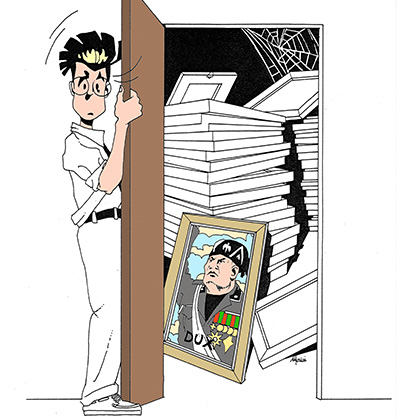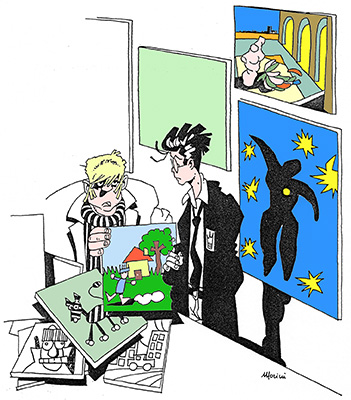Frames and Profits
What should the profit percentage be on the frames?
It depends on various situations, on the type of activity, etc. Normally, a framer should not have a profit inferior to 20% of sales. If, for example, monthly sales are £10,000 a month, the profit should be around £2,000. Under this profit margin one's money would be invested in a risky business. It would be better at this point to invest in something else. The sales price of the frames must include material, labour, general expenses and profit. The proportion of various components is summarily listed below:
Material cost (moulding, glass, etc.) 30%
Labour (including owner's work) 30%
General expenses (rent, telephone, etc.) 20%
Profit 20%
Sales price 100%
If you cannot cut down expenses, you have to increase the sales price. There is no other alternative. If, after a beginning period of one year, you cannot make a sufficient profit, you'd better start thinking of closing the shop.
Frames not collected
My shop is full of frames which have not been collected by customers. What should I do?
This is a common problem with framers. Of course you have to try to contact the customers by telephone. For frames which have not been collected for a long time there is often no other solution than to disassemble the picture and reuse the frames. The disassembled pictures must be kept together with customer data in case they are requested later.

The important thing for the future is, however, to find a solution before the problem comes out.
First of all, you have to write the customer’s name, telephone number and possibly his address on the frame order form. This would allow you to reach the client if need be. It is also important that on the order form you mention the promised delivery date and that the customer is informed that he has to come to collect the frames without further notice. If after a couple of days the client has not collected the frames, you must call him to let him know that his frames are ready. Other telephone calls could be made every 3/4 days.
Another way to solve this problem is to not give very long delivery times. The delivery time which does not exceed a week helps to avoid the client losing interest in his frames or even to forget having brought them to be framed. The most important thing, however, is to ask for a deposit. Many framers are hesitant in doing this because they think the customer will get upset. We must try and overcome this hindrance. A suitable phrase in this case might be, "Do you prefer to pay now or leave a deposit?". A placard made for this purpose would facilitate this. If the client has left a deposit, he will be more interested in collecting his framed pictures.
Discount to artists
Some local framers grant discounts to painters. Should I do the same?
The discount problem is widespread and there is no common solution; each one of us should adopt a policy that is appropriate for our shop. It is obvious that a painter that regularly gives us a lot of work should be treated better than the customer that comes into our shop once a year. I would suggest a 10% discount in these cases. In order to further tie the customer to our shop it might be advisable to immediately offer him a 5% discount; another 5% at the achievement of a certain volume of sale and a further 5% at the achievement of an even higher level of sales. Our prices need to be such that once discounted we will not be incurring a loss. It is also necessary to grant the discount only to the painter and not to all the clients that the painter sends to us.
Bad quotation
I quoted a hospital for 150 "50 x 70 cm frames" (3 cm thick moulding). I felt I kept the prices pretty low and yet I lost the job to another framer. Where did I go wrong?
Prices of frames as you well know vary according to the different mouldings used. The purchasing departments of these institutions don't know this and as far as they are aware all frames with a 3 cm thick moulding are the same and hence have the same price. The framer that got the job probably quoted frames with a very cheap moulding (for example a simple brown moulding instead of a quality walnut one). It would also have been handy to hand over the different prices together with the samples of each moulding quoted.
A frameless framed poster
Sometimes a customer sees a poster or print displayed and wants to buy it... but without the frame. Sometimes they want it with a different frame. What should you do in these circumstances?
It depends on the price of the poster or print displayed. If the value of it is rather low compared to the value of the frame then we must tell the client that it is not possible and explain why. If this is not the case then we should accept the customer's request and remove the poster or print from the frame. We can utilise the frame for another poster. We will not be compensated for the time it took us to apply the poster but we will make some profit from the sale of the poster. One small piece of advice; in order to avoid wasting a lot of time, don't cover the back of the frame. You will thus save a few minutes removing the back whenever the customer makes this special request.
Artist's paintings
I am submerged in paintings, or so called ones, given to me by artists that pay for the frames in this manner. What should I do?
If there was a Picasso amongst them then it would be great but this is often not the case. You should not accept this situation. Clearly state that you are in need of cash in order to make the business survive. Pictures can become cash but only after a long period of time. If the paintings are saleable then you could accept them on consignment and give the money to the artist only once you have sold them.

Commission on sales
What commission should I keep for painters that leave their work with me?
Generally framers and galleries keep about a third. If however the pictures are purchased by the framer then his profit should be higher. The selling price should be about double that paid to the painter.
Leasing frames
Every so often a painter asks me to hire some frames for a display of theirs. What should I do?
Generally the hire of frames is not advisable unless the hire charge is at least half the selling price of the frames. In fact when the frames are returned they are usually in such a state that they can no longer be sold. I wouldn’t even get your hopes up on the fact that certain frames may be sold with the print on display.